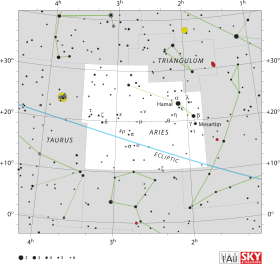Caractéristiques physiques
Masse
1,69 ± 0,48 M ☉ [ 4]
Rayon
11,12+0,34 R ☉ [ 1]
Gravité de surface (log g)
2,50 ± 0,11[ 4]
Luminosité
58,2 ± 0,7 L ☉ [ 1]
Température
4 780+120 K [ 1]
Métallicité
−0,02 ± 0,05[ 4]
Âge
2,0+1,0 Ga [ 4]
Désignations
modifier
HD 12139 est une étoile de couleur orange de la constellation du Bélier . Avec une magnitude apparente visuelle de 5,89[ 2] œil nu dans de bonnes conditions. Elle se situe à environ 351 années-lumière parsecs Terre , d'après la parallaxe [ 2] vitesse radiale de −2 km/s [ 1] courant d'Hercule (en) [ 6]
C'est une géante rouge vieillissante [ 7] type spectral K0III-IV[ 3] hydrogène de son noyau rayon du Soleil [ 1] milliards d'années [ 4] masse du Soleil [ 4] luminosité du Soleil [ 1] photosphère à une température effective de 4 780 K [ 1]
Un compagnon avec une magnitude de 9,36 est situé à une distance angulaire de 199,70″ du primaire le long d'un angle de position de 9°, en date de 2015. On ne sait pas si les deux sont physiquement associés[ 8]
↑ a b c d e f g h i j k l et m
(en) A. G. A. Brown et al. Gaia collaboration), « Gaia Data Release 2 : Summary of the contents and survey propertiesAstronomy & Astrophysics vol. 616, août 2018 , article no A1 (DOI 10.1051/0004-6361/201833051 Bibcode 2018A&A...616A...1G arXiv 1804.09365
↑ a b c d et e (en) E. Anderson et Ch. Francis, « XHIP: An extended hipparcos compilation Astronomy Letters vol. 38, no 5, 2012 , p. 331 (DOI 10.1134/S1063773712050015 Bibcode 2012AstL...38..331A arXiv 1108.4971 S2CID 119257644 ↑ a et b (en) Kenneth M. Yoss, « Spectral and Luminosity Classifications and Measurements of the Strength of Cyanogen Absorption for Late-Type Stars from Objective-Prism Spectra The Astronomical Journal vol. 134, novembre 1961 , p. 809 (DOI 10.1086/147209 Bibcode 1961ApJ...134..809Y ↑ a b c d e et f (en) Diane K. Feuillet et al. Determining Ages of APOGEE Giants with Known Distances The Astronomical Journal vol. 817, no 1, 2016 , p. 40 (DOI 10.3847/0004-637X/817/1/40 Bibcode 2016ApJ...817...40F arXiv 1511.04088 S2CID 118675933 ↑ (en) HD 12139 sur la base de données Simbad Centre de données astronomiques de Strasbourg .↑ (en) P. Ramya et al. Chemical compositions and kinematics of the Hercules stream Monthly Notices of the Royal Astronomical Society vol. 460, no 2, août 2016 , p. 1356−1370 (DOI 10.1093/mnras/stw852 Bibcode 2016MNRAS.460.1356R arXiv 1604.04821 ↑ (en) Yoichi Takeda et Akito Tajitsu, « Spectroscopic study on the beryllium abundances of red giant stars Publications of the Astronomical Society of Japan vol. 66, no 5, 2014 , p. 91 (DOI 10.1093/pasj/psu066 Bibcode 2014PASJ...66...91T arXiv 1406.7066 ↑ (en) B. D. Mason et al. The Washington Visual Double Star Catalog The Astronomical Journal vol. 6, 2014 , p. 3466 (DOI 10.1086/323920 Bibcode 2001AJ....122.3466M
Liens externes
Ressource relative à l'astronomie :
